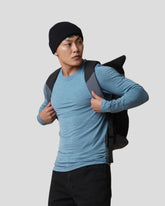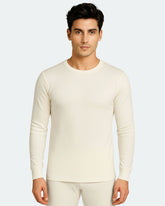Base Layer 101 – Everything you need to know about thermal and base layers
Did you know that your base layers are not supposed to keep you warm? Yes, you heard that right. But before you come at us, hear us out.
Base layers ‘prevent’ you from getting cold. Not keep you warm.
And when you understand this basic rule, you’re more likely to enjoy your winters and the plummeting temperatures more easily.
Base layers ‘prevent’ you from getting cold. Not keep you warm. And when you understand this basic rule, you’re more likely to enjoy your winters and the plummeting temperatures more easily.
As winter outfitters, we often get asked which base layers to buy that keep you warm. While we advocate layering, many people think that layering is all about adding one warm piece of clothing over another. This, unfortunately, is one of the biggest mistakes of winter dressing. Winter dressing requires caution, especially if you are partaking in activities such as hiking. Many people put on too many layers thinking that the more they layer, the warmer they will get.
But what happens is something else. You end up drenching yourself in sweat and the moment you stop, even for a short break, the sweat makes you colder! A base layer can’t keep you warm if you are sweating and static!
So what is the solution?
Understanding what base layers do
To understand how to use base layers let’s first understand the heat loss quarter. Energy loss in the form of heat takes place by:
Conduction – contact between two objects with different temperatures, like your body and the air
Convection – the movement of air carries the energy away, i.e: wind chill
Radiation – transfer of heat without direct contact via infrared rays, like sun heat
Evaporation – energy loss from the transfer of liquid to gas, i.e: sweat
Conduction requires insulation to prevent direct contact with cold air, rain, or snow. For convection, you need wind and waterproof layers. Radiation needs even thicker insulation to push the colder air away from the body, while evaporation needs base layers to prevent sweat evaporation from the skin but to facilitate it from the base layer itself.
Base layers deliver conduction and prevent heat loss from radiation and convection because of the fabric. The smarter, more ergonomic base layers offer greater insulation. But at their core, the main job of the base layer is to prevent evaporation.
But first, let’s clarify: what exactly is a base layer?
What is a base layer?

Merino wool Base layers, also known as long johns, are one part of the three layering methods. Base layers are the first, and innermost layers, with one objective – to keep you dry as you sweat!
Base layers regulate the body temperatures in the cold and prevent perspiration from your skin to transfer to the fabric. This moisture-wicking quality keeps you dry and hence, comfy and warm.
How to choose Thermal Wear / Base Layers
Choosing a base layer that provides warmth and comfort depends on three important factors. Here’s how to choose the best base layers for your needs.
Fit
Don’t blame your base layer if it’s not a snug fit. Hence, it is a no-brainer to get these garments in a size that is almost skin-tight. But a good base layer fits like a second skin - it should be snug without feeling like it's cutting off circulation! At the same time, you don’t want the base layer to bunch up as well.
Material
The material of the base layer drives its performance. Remember we mentioned that base layers wick away moisture? Here choosing the fabric of the base layer comes into play. Absorbent materials draw perspiration from the skin as fast as possible. Fabrics like polyester are a popular choice since they allow movement and can be quite affordable. However, synthetic fabrics do tend to stink up!
Fabrics like merino wool and bamboo offer the same flexibility, softness and fit but with greater moisture-wicking capabilities. They offer great movement and comfort while being odour-free! Read more about merino wool base layers here.
Comfort
Your base layers should not restrict movement. In fact, you will not even feel like you are wearing a base layer if you choose the right one. Your base layer should not restrict you from stretching, twisting, running, jumping, or anything else you do while you’re out having fun in the cold or snow.
A good base layer will act as a protective barrier and also, prevent chafing from heavier fabrics, zippers, and other harsh materials. High-quality base layers feel nice and soft against the skin and cover as much exposed skin as possible.
That is why it is a great idea to get long sleeves and tights as base layer garments.
Why do base layers matter?

Have you ever felt a sudden, chilling sensation on your skin, even when bundled up?
That's skin chill. Skin chill is a difficult condition that can occur when sweat evaporates quickly in cold, windy conditions. It can lead to hypothermia, a serious medical condition.
A base layer is your first line of defence against skin chill. It works by wicking moisture away from your skin, keeping you dry and comfortable. This is crucial, as wet skin loses heat much faster than dry skin.
When to Wear a Base Layer?

Cold and Windy Conditions: If you're planning to be outdoors in cold, windy weather, a merino wool base layer is essential.
High-Intensity Activities: Your body generates heat during activities like hiking, skiing, or snowboarding. A base layer helps regulate your body temperature and prevent overheating.
Rest Periods: When you're not actively moving, your body temperature can drop quickly. A base layer will help keep you warm during breaks.
In general wearing base layers during winters when you go hiking, backpacking, running, cycling, climbing, pretty much any outdoor adventure or activity is a great idea. If you tend to get hotter faster and sweat more, then make base layers your best friend to prevent cooling down rapidly and catching a chill. Base layers are also great for areas where there is higher wind chill.
Which fabric base layers to buy?
Cotton: A No-Go
Cotton is a popular choice for everyday wear, but it's a terrible choice for base layers. It absorbs moisture like a sponge, dries slowly, and leaves you feeling cold and clammy.
Merino Wool: The Classic Choice
Merino wool base layers have been a popular choice. It's naturally odour-resistant, temperature-regulating, and moisture-wicking. However, it can be more expensive and less durable than synthetic options.
Polyester: Affordable
Polyester is another popular synthetic fibre that offers a good balance of performance and affordability. It's moisture-wicking, and durable, but does not offer an odour-free experience.
Plus, plastic-based textile economy has led to the unsustainable overproduction of clothing. It has a very high environmental cost. Every wash of polyester clothing releases thousands of tiny synthetic fibres which ultimately end up in the rivers, lakes, and oceans.
The chemicals, including dyes and finish resins, used in the manufacturing process of polyester also pose health risks to the consumer.
Read more about Making Sustainable Choices: Polyester vs. Natural Fibres here.
Bamboo: A Sustainable Alternative
Bamboo is a natural fibre that's soft, breathable, and eco-friendly. However, its performance can vary depending on the manufacturing process. It may not be as effective as merino wool or synthetic fibres in extreme conditions.
Merino + bamboo – the ultimate match
Bamboo when combined with merino wool becomes a match made in heaven for base layers. Merino wool and bamboo base layers transform the base layer design to make them super soft, highly functional, and temperature-adaptive. It feels super soft against the skin and offers greater durability as compared to just merino wool or bamboo base layers. This fabric composition makes the base layers more breathable and allows you to be comfortable while chilling indoors or enjoying outdoor activities.
The Kosha base layers are made from 47.5% Merino Wool, and 47.5% Bamboo with 5% Elastane for stretchability which includes Thermal Leggings and Thermal Long Sleeve Shirts – is designed to be worn under your normal clothing, providing an extra layer for maximum warmth. These can be layered easily and work well as full-sleeve tees. With additional layers, our merino wool base layers can take you up to -15°C. Without a shell and outer layers, it is perfect for up to 10°C.
Base layers have to look good, feel comfortable, and be body-friendly. Our base layers deliver all of these and along with that, pack small and feel like silk. In fact, we have been told that our base layers while light as air but effective in frigid temperatures. So whether you are chilling in a cold country, going for lazy hikes or tough ones, or skiing, our base layers have you covered and offer you the support needed to enjoy your winter adventures!
Connect with us online or hop into our store to explore our range of winter garments meant for the conscious, urban, stylish adventurer.





